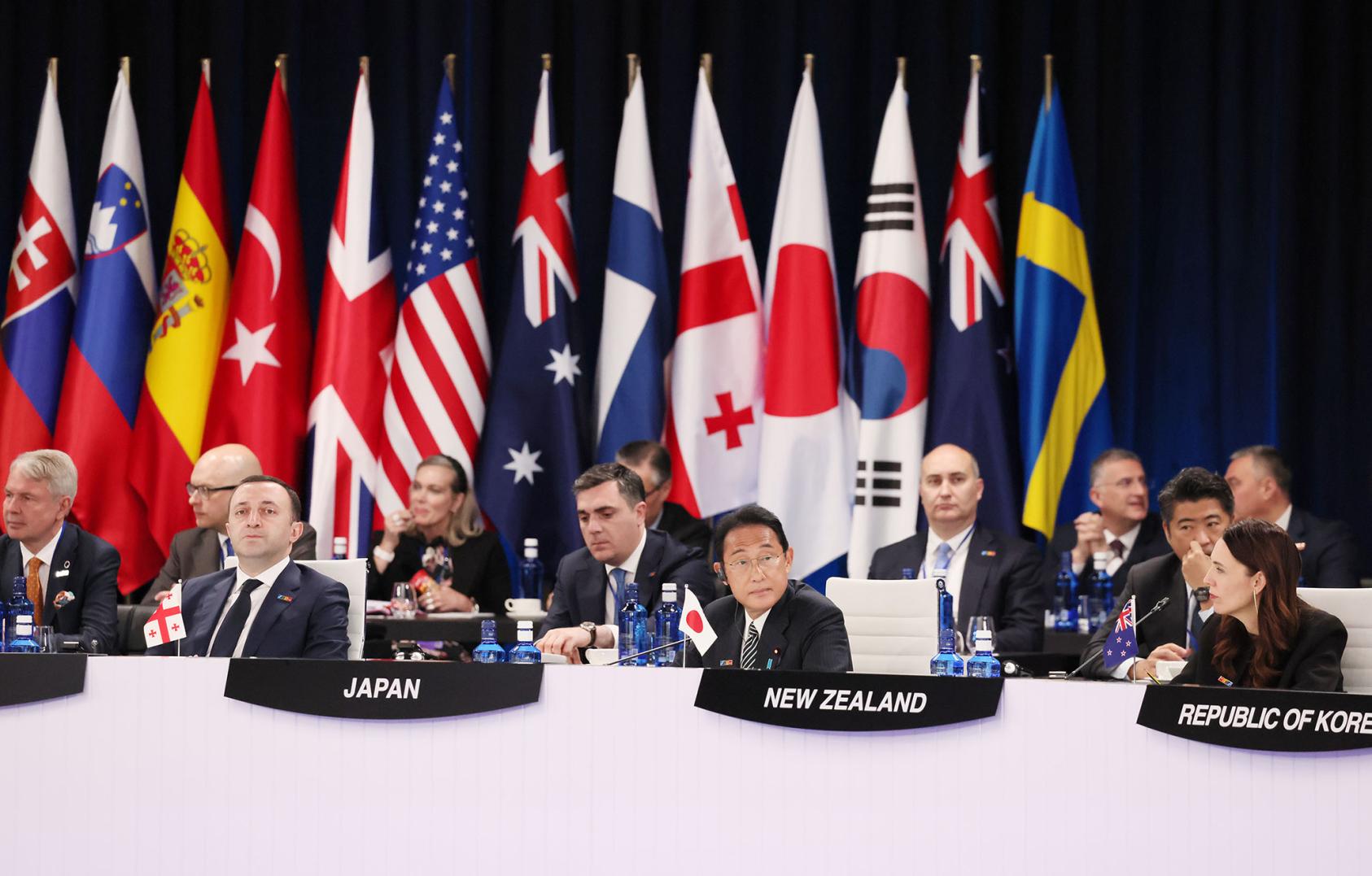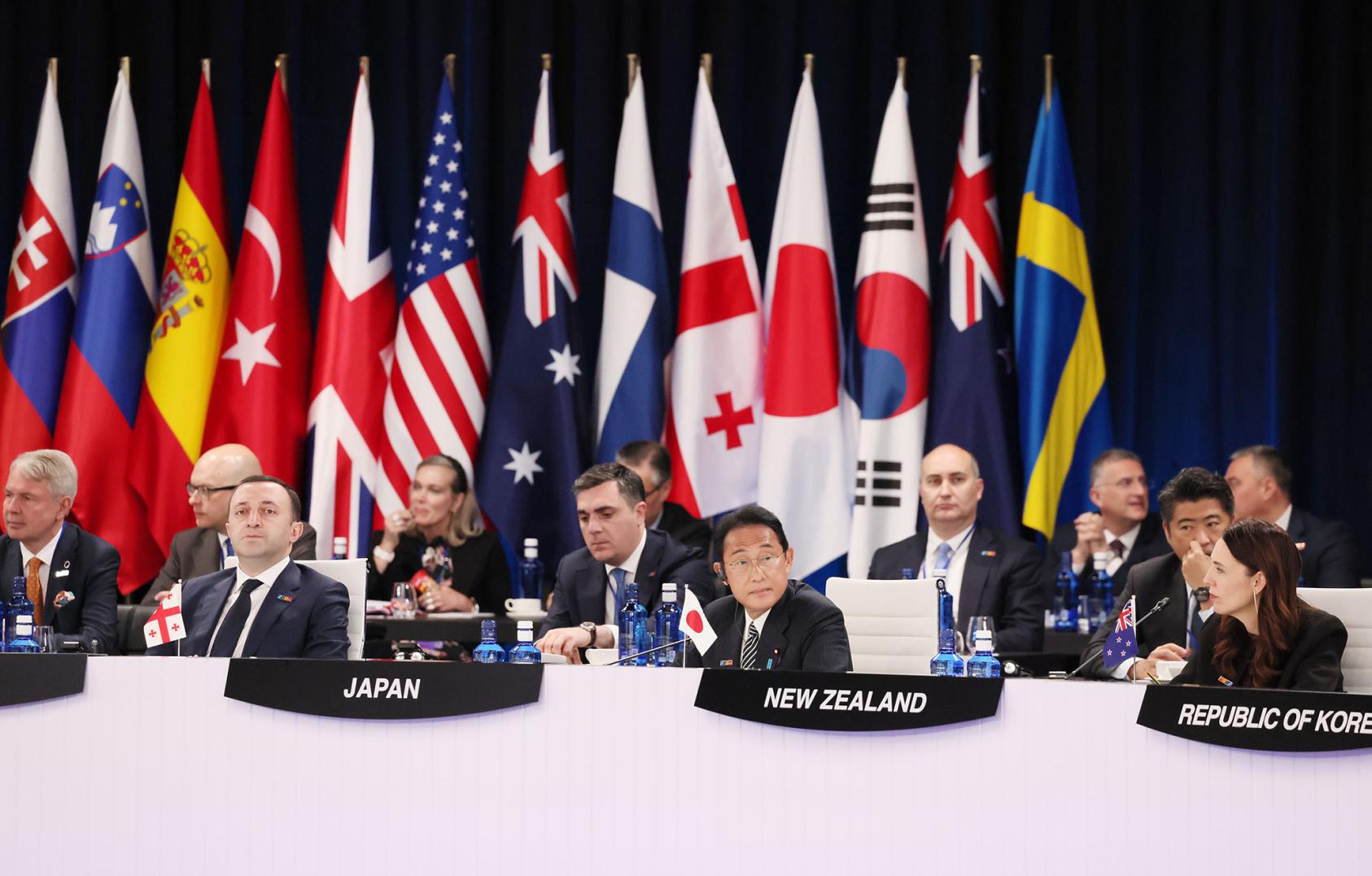The alliance is deepening its relationships with key Indo-Pacific partners to pull together a more global, like-minded coalition.
As NATO celebrates its 75th anniversary this year, the Euro-Atlantic security alliance continues to deepen its engagement with Australia, Japan, South Korea and New Zealand, collectively known as the IP4. NATO has collaborated with these countries since the early 2000s, but Russia’s war against Ukraine, security challenges posed by China and renewed strategic competition have led to increased engagement. As the war in Ukraine grinds on and U.S.-China competition shows no sign of abating, the United States has much to gain from collaboration between its allies and partners in the Euro-Atlantic and Indo-Pacific.

A recent USIP expert study group report looks at Indo-Pacific partners’ perspectives on NATO, as well as the dynamics of NATO and Indo-Pacific partner relations. USIP’s Mirna Galic, who chaired the study group, discusses how the alliance’s engagement in the Indo-Pacific has evolved due to Russia’s war in Ukraine and security challenges posed by China and how collaboration can be mutually beneficial for NATO and the IP4.
The following contains excerpts from the expert study group report.
How has engagement between NATO and its Indo-Pacific partners evolved in response to the security challenges posed by Russia’s war in Ukraine and the growing awareness of threats from China?
It’s important to give some context to NATO’s engagement with its Indo-Pacific partner countries and on the region from a historical perspective. NATO’s relationships with Australia, Japan, South Korea and New Zealand were formalized with partnership agreements back in the early 2010s. But before then, NATO started engaging with Japan in the early 1990s and all four of these countries cooperated with the alliance in the early 2000s on Afghanistan.
Moreover, NATO undertook counter-piracy missions in the Indian Ocean between 2009 and 2016. Also in 2016, NATO first started meeting with the Indo-Pacific partners as a group of four, based on its interest in better understanding the deteriorating security situation with North Korea. All of this precedes the alliance’s recognition of China posing security challenges for NATO, which was not featured in a high-level NATO public document until the end of 2019.
NATO-IP4 engagement has been evolving for some time — and continues to evolve. Certainly, as NATO began to assess more methodically the challenges posed by China, beginning in 2019, engagement with the IP4 expanded to encompass this topic as well. These partners share a region with China and bring unique insights into the regional security situation as well as the ways in which China is pushing back against the rules-based international order.
After the start of Russia’s war against Ukraine in February 2022, NATO brought these partners to discussions on this issue as well. For all four countries, Russia’s invasion is deeply problematic and greatly raised awareness about the repercussions threats to European security can have in the Indo-Pacific — not only in terms of second order effects on economies or energy and food security, but also because of Russia’s rejection of the rules-based international order, which is problematic both in itself and because of the signals it may send to China and North Korea.
So, what we are really seeing is a deepening of relations between these partners and NATO as a result of an increasing number of shared interests and threat perceptions, as well as a growing recognition on both sides of connections between Indo-Pacific and Euro-Atlantic security.
What are the perceived benefits of the IP4 grouping for NATO and the Indo-Pacific partner countries? What are the plans for the future of the grouping?
As we discuss in greater detail in the report, NATO began to engage with the Indo-Pacific partners as a group of four in 2016, six years before the IP4 grouping burst onto the global stage in June 2022 with the historic participation of these Indo-Pacific leaders at the NATO summit in Madrid. The IP4 grouping will likely continue to exist for the foreseeable future as a NATO mechanism for engagement on issues of mutual interest.
For the alliance, the grouping facilitates NATO’s ability to gather its member states together with like-minded partners from an important region and underscores the significance of the Indo-Pacific. But the IP4 grouping remains an informal mechanism, unlike NATO’s regionally based, formalized partnership frameworks — the Partnership for Peace, Mediterranean Dialogue and Istanbul Cooperation Initiative — although it has taken on aspects of a de facto regional partner grouping. This appears consistent with the views of both allies and partners, however, with no current demand from either side for greater formalization. The benefits of informality include greater flexibility and less of a hook for China to raise false alarms about a so-called Asia-Pacific NATO.
The IP4 grouping is also not meant to replace or be privileged above bilateral relations between NATO and its Indo-Pacific partner countries, which remain of prime importance to the partners, but instead to be a complementary avenue of engagement. There are indeed certain advantages — namely, access, inclusion and safety in numbers — to the grouping for the partner countries as well as those for NATO.
In terms of access and inclusion, the four countries as a group get much greater attention and space at NATO than any one of them alone would enjoy. The IP4 also provides a framework for engagement and deepening of relations between the Indo-Pacific partner countries themselves and facilitates valuable diplomatic opportunities on the sidelines of high-level NATO meetings.
Regarding safety in numbers, Indo-Pacific partner countries can deflect Chinese displeasure at their engagement with NATO more effectively as a group than individually. The grouping also helps facilitate increasing internal links between the hubs of the traditional U.S. hub-and-spoke alliance system in the region. Additionally, the IP4 can provide a platform for engagement that could be controversial if done bilaterally when tensions between two countries are high, as was previously the case between Japan and South Korea.
More generally, the IP4 grouping has the potential to magnify common views and interests beyond what a single country’s voice could do. Likewise, it may be especially useful in areas that could benefit from coordination between the Indo-Pacific partners before engagement between the IP4 and NATO. For example, in a potential exchange between NATO and the IP4 on lessons from Ukraine for a regional contingency, there may be value in the Indo-Pacific partners first discussing together any specific areas that would be important to highlight from a regional perspective, such as ASEAN’s views or Beijing’s perceptions.
Despite a recognition of these kinds of benefits, it does not seem that the four partner countries yet see the IP4 grouping as a strategic asset for maximizing national and regional gains from NATO engagement. Taking a look at this area internally and then in consultation with one another would therefore be prudent. NATO too has some work to do in this regard, as the extent to which the alliance sees the IP4 as a useful unit, rather than just a collection mechanism or a way to emphasize the importance of the Indo-Pacific region, remains unclear.
The issue may simply be competing views within NATO, where some allies are more ambitious about the IP4 format and some less so, leaving NATO’s international staff to navigate a middle ground. So, the future of the grouping is yet to be determined and will need some additional focus from both allies and partners. Another way to look at this, however, is that the grouping continues to evolve.
What are the partner countries looking for in terms of coordination and collaboration with NATO?
In terms of the Indo-Pacific region, the partner countries don’t appear to expect NATO to be a significant direct actor in the Indo-Pacific, but instead to coordinate with them on issues of mutual concern in, stemming from, or affecting the Indo-Pacific. In our report, we summarize this as the notion of “NATO with the Indo-Pacific not in the Indo-Pacific,” meaning NATO and Indo-Pacific partners sharing knowledge and experiences and coordinating responses rather than intervening in each other’s regional military crises, with the Ukraine-related sanctions and aid delivery an example of how the reactions of NATO and Indo-Pacific partners could be synced.
Just as the partner countries have understood that what Russia does in Europe can impact security in their region, they also want NATO allies to understand that what China does in the Indo-Pacific, not just what it does in Europe, can also impact European security.
Regarding coordination on issues of mutual concern, 10 priority areas were agreed between NATO and the Indo-Pacific partners in 2022. Although these are not public, they likely include emerging and disruptive technologies, countering disinformation, maritime security, climate change, space, cyber defense and innovation. How practical cooperation may be developed in these areas is being addressed through regular discussion between NATO and IP4 governments.
The study group also looked at some additional areas that might benefit from coordination or cooperation between NATO and the Indo-Pacific partners. These included nonproliferation and arms control, China-Russia relations, the polar regions, supply chains, artificial intelligence, defense industry planning and coordination, and defense supply-chain management.
It is also important to remember that the IP4 are not monolithic in their views regarding NATO coordination and cooperation and that the individual countries have a variety of interests and priorities in this regard. These can be pursued through new partnership agreements signed between NATO and Australia, Japan, and South Korea in 2023 and currently under discussion between NATO and New Zealand. These new agreements are more detailed than the previous partnership deals and include strategic objectives and concrete partnership goals.
In light of Russian disinformation efforts and China’s negative messaging about NATO, how should the alliance address challenges related to public diplomacy aimed at the Indo-Pacific partner countries?
One easy thing NATO can do is highlight its long-standing engagement with these partners and their region and clarify the nature of the IP4 grouping. Messaging about the Indo-Pacific could underscore that NATO’s engagement with its partners and the region long precedes the alliance’s acknowledgment of China as a security challenge; explain that the IP4 is not a formalized framework; and emphasize that it is not meant to replace or be privileged over bilateral relations. Such messaging is relevant not only for the broader Indo-Pacific region but also for media and domestic audiences in Indo-Pacific partner countries, whose familiarity with both NATO’s history regarding the Indo-Pacific and with the IP4 grouping remains low.
Indeed, there is still relatively limited understanding of NATO’s remit, processes and relevance to national interest at public levels in all four countries and, to varying degrees, even within policy circles across. There are various explanations for this from the partner side, including silos within bureaucracies between European and North American affairs, finite resources for Brussels representation, limited bureaucratic bandwidth and sparse interest within the expert community. NATO also bears responsibility, however, due to its limited reach to Indo-Pacific partner capitals, including through its public diplomacy division and from a lack of consistency in the NATO contact point embassy model, through which the alliance shares information with partner governments and coordinates public diplomacy in partner countries.
More work certainly needs to be done on this point at NATO, but the good news is that it has already begun. NATO’s public diplomacy division has recognized past problems and taken steps to improve the functioning of NATO’s contact point embassy model. Moreover, high-level visits to the partner countries by NATO officials and by national officials to NATO are increasing and these generally increase public interest and awareness.
The uptick in high-profile NATO visits to the Indo-Pacific region in recent years and the increasing frequency with which Indo-Pacific partner foreign ministers have been included in meetings of their NATO counterparts — on top of a third expected participation by Indo-Pacific leaders at a NATO summit meeting this summer in Washington — suggest that visits by officials may grow to be a more reliable platform for highlighting NATO in the years to come.
